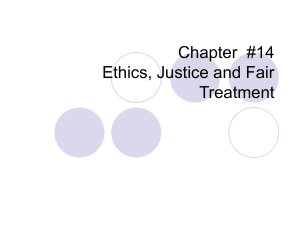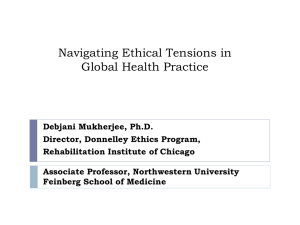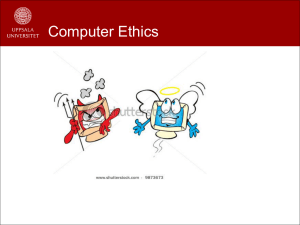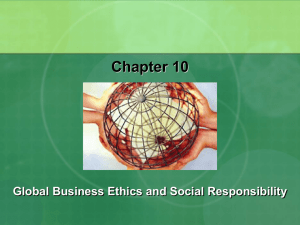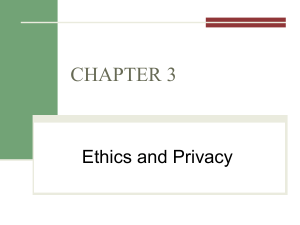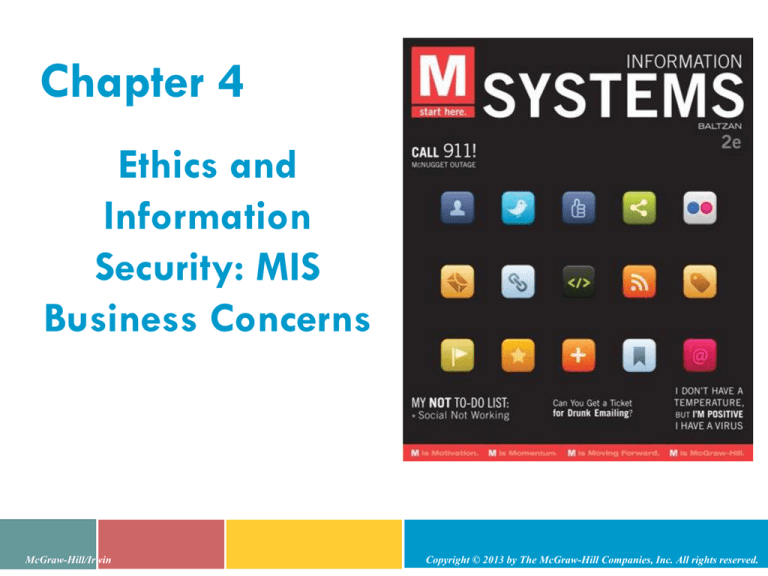
Chapter 4
Ethics and
Information
Security: MIS
Business Concerns
McGraw-Hill/Irwin
Copyright © 2013 by The McGraw-Hill Companies, Inc. All rights reserved.
CHAPTER OVERVIEW
Chapter 4
• SECTION 4.1 – Ethics
Information Ethics
Developing Information Management Policies
Ethics in the Workplace
• SECTION 4.2 – Information Security
Protecting Intellectual Assets
The First Line of Defense - People
The Second Line of Defense - Technology
4-2
Chapter 4
SECTION 4.1
Ethics
4-3
LEARNING OUTCOMES
Chapter 4
1.
Explain the ethical issues in the use of the
information age
2.
Identify the six epolicies an organization should
implement to protect itself
4-4
INFORMATION ETHICS
Chapter 4
• Ethics – The principles and standards
that guide our behavior toward other
people
• Information ethics – Govern the
ethical and moral issues arising from
the development and use of
information technologies, as well as the
creation, collection, duplication,
distribution, and processing of
information itself
4-5
INFORMATION ETHICS
Chapter 4
• Business issues related to information ethics
Intellectual property
Copyright
Pirated software
Counterfeit software
4-6
INFORMATION ETHICS
Chapter 4
• Privacy is a major ethical issue
Privacy – The right to be left alone when you
want to be, to have control over your own
personal possessions, and not to be observed
without your consent
Confidentiality – the assurance that messages
and information are available only to those
who are authorized to view them
4-7
INFORMATION ETHICS
Chapter 4
• Individuals form the only ethical component of
MIS
Individuals copy, use, and distribute software
Search organizational databases for sensitive and
personal information
Individuals create and spread viruses
Individuals hack into computer systems to steal
information
Employees destroy and steal information
4-8
INFORMATION ETHICS
Chapter 4
• Acting ethically and legally are not always the same
4-9
Information Does Not Have Ethics,
People Do
Chapter 4
• Information does not care how it is used, it will not stop
itself from sending spam, viruses, or highly sensitive
information
• Tools to prevent information misuse
Information management
Information governance
Information compliance
Ediscovery
4-10
DEVELOPING INFORMATION
MANAGEMENT POLICIES
Chapter 4
• Organizations strive to build a corporate culture
based on ethical principles that employees can
understand and implement
• Epolicies typically include:
Ethical computer use policy
Information privacy policy
Acceptable use policy
Email privacy policy
Social media policy
Workplace monitoring policy
4-11
Ethical Computer Use Policy
Chapter 4
• Ethical computer use policy – Contains
general principles to guide computer user
behavior
• The ethical computer user policy ensures all
users are informed of the rules and, by
agreeing to use the system on that basis,
consent to abide by the rules
4-12
Information Privacy Policy
Chapter 4
• The unethical use of information typically occurs
“unintentionally” when it is used for new purposes
• Information privacy policy - Contains general
principles regarding information privacy
4-13
Acceptable Use Policy
Chapter 4
• Acceptable use policy (AUP) – Requires a user to
agree to follow it to be provided access to corporate
email, information systems, and the Internet
• Nonrepudiation – A contractual stipulation to ensure
that ebusiness participants do not deny their online
actions
• Internet use policy – Contains general principles to
guide the proper use of the Internet
4-14
Email Privacy Policy
Chapter 4
• Organizations can mitigate the risks of email and
instant messaging communication tools by
implementing and adhering to an email privacy policy
• Email privacy policy – Details the extent to which
email messages may be read by others
4-15
Email Privacy Policy
Chapter 4
4-16
Email Privacy Policy
Chapter 4
• Spam – Unsolicited email
• Anti-spam policy – Simply states that
email users will not send unsolicited
emails (or spam)
4-17
Social Media Policy
Chapter 4
• Social media policy – Outlines
the corporate guidelines or
principles governing employee
online communications
4-18
WORKPLACE MONITORING POLICY
Chapter 4
• Workplace monitoring is a concern for many
employees
• Organizations can be held financially responsible for
their employees’ actions
• The dilemma surrounding employee monitoring in the
workplace is that an organization is placing itself at
risk if it fails to monitor its employees; however, some
people feel that monitoring employees is unethical
4-19
WORKPLACE MONITORING POLICY
Chapter 4
• Information technology monitoring –
Tracks people’s activities by such
measures as number of keystrokes, error
rate, and number of transactions
processed
• Employee monitoring policy – Explicitly
state how, when, and where the company
monitors its employees
4-20
WORKPLACE MONITORING POLICY
Chapter 4
• Common monitoring technologies include:
Key logger or key trapper software
Hardware key logger
Cookie
Adware
Spyware
Web log
Clickstream
4-21
Chapter 4
SECTION 4.2
INFORMATION SECURITY
4-22
LEARNING OUTCOMES
Chapter 4
3.
Describe the relationships and differences between
hackers and viruses
4.
Describe the relationship between information
security policies and an information security plan
5.
Provide an example of each of the three primary
security areas: (1) authentication and authorization,
(2) prevention and resistance, and (3) detection and
response
4-23
PROTECTING INTELLECTUAL ASSETS
Chapter 4
• Organizational information is intellectual
capital - it must be protected
• Information security – The protection of
information from accidental or intentional
misuse by persons inside or outside an
organization
• Downtime – Refers to a period of time
when a system is unavailable
4-24
PROTECTING INTELLECTUAL ASSETS
Chapter 4
Sources of Unplanned Downtime
4-25
PROTECTING INTELLECTUAL ASSETS
Chapter 4
How Much Will Downtime Cost Your Business?
4-26
Security Threats Caused by Hackers and
Viruses
Chapter 4
Hacker – Experts in technology who use their
knowledge to break into computers and
computer networks, either for profit or just
motivated by the challenge
•
Black-hat hacker
Cracker
Cyberterrorist
Hactivist
Script kiddies or script bunnies
White-hat hacker
4-27
Security Threats Caused by Hackers and
Viruses
Chapter 4
Virus - Software written with malicious intent to
cause annoyance or damage
•
Backdoor program
Denial-of-service attack (DoS)
Distributed denial-of-service attack (DDoS)
Polymorphic virus
Trojan-horse virus
Worm
4-28
Security Threats Caused by Hackers and
Viruses
Chapter 4
How Computer Viruses Spread
4-29
Security Threats Caused by Hackers and
Viruses
Chapter 4
• Security threats to ebusiness include
Elevation of privilege
Hoaxes
Malicious code
Packet tampering
Sniffer
Spoofing
Splogs
Spyware
4-30
THE FIRST LINE OF DEFENSE - PEOPLE
Chapter 4
• Organizations must enable employees, customers, and
partners to access information electronically
• The biggest issue surrounding information security is not a
technical issue, but a people issue
Insiders
Social engineering
Dumpster diving
4-31
THE FIRST LINE OF DEFENSE - PEOPLE
Chapter 4
• The first line of defense an organization should follow to
help combat insider issues is to develop information
security policies and an information security plan
Information security policies
Information security plan
4-32
THE SECOND LINE OF DEFENSE TECHNOLOGY
Chapter 4
•
There are three primary information
technology security areas
1.
People: Authentication and authorization
2.
Data: Prevention and resistance
3.
Attack: Detection and response
4-33
Authentication and Authorization
Chapter 4
•
Identity theft – The forging of
someone’s identity for the purpose of
fraud
•
Phishing – A technique to gain
personal information for the purpose of
identity theft, usually by means of
fraudulent email
•
Pharming – Reroutes requests for
legitimate websites to false websites
4-34
Authentication and Authorization
Chapter 4
•
Authentication – A method for confirming users’
identities
•
Authorization – The process of giving someone
permission to do or have something
•
The most secure type of authentication involves
1.
Something the user knows
2.
Something the user has
3.
Something that is part of the user
4-35
Something the User Knows Such as a User ID and
Password
Chapter 4
•
This is the most common way to
identify individual users and
typically contains a user ID and a
password
•
This is also the most ineffective form
of authentication
•
More than 50 percent of help-desk
calls are password related
4-36
Something the User Knows Such As a User ID and
Password
Chapter 4
Smart cards and tokens are more effective
than a user ID and a password
•
Tokens – Small electronic devices that change
user passwords automatically
Smart card – A device that is around the same
size as a credit card, containing embedded
technologies that can store information and
small amounts of software to perform some
limited processing
4-37
Something That Is Part of the User Such as a
Fingerprint or Voice Signature
Chapter 4
This is by far the best and most effective way
to manage authentication
•
•
Biometrics – The identification of a user based on
a physical characteristic, such as a fingerprint, iris,
face, voice, or handwriting
Unfortunately, this method can be costly and
intrusive
4-38
Prevention and Resistance
Chapter 4
•
Downtime can cost an organization anywhere from
$100 to $1 million per hour
•
Technologies available to help prevent and build
resistance to attacks include
1.
Content filtering
2.
Encryption
3.
Firewalls
4-39
Prevention and Resistance
Chapter 4
•
Content filtering - Prevents emails
containing sensitive information
from transmitting and stops spam
and viruses from spreading
4-40
Prevention and Resistance
Chapter 4
If there is an information security breach and the
information was encrypted, the person stealing the
information would be unable to read it
•
Encryption
Public key encryption (PKE)
Certificate authority
Digital certificate
4-41
Prevention and Resistance
Chapter 4
4-42
Prevention and Resistance
Chapter 4
•
One of the most common defenses
for preventing a security breach is
a firewall
•
Firewall – Hardware and/or
software that guards a private
network by analyzing the
information leaving and entering
the network
4-43
Prevention and Resistance
Chapter 4
•
Sample firewall architecture connecting systems
located in Chicago, New York, and Boston
4-44
Detection and Response
Chapter 4
•
If prevention and resistance
strategies fail and there is a
security breach, an organization
can use detection and response
technologies to mitigate the
damage
•
Intrusion detection software –
Features full-time monitoring tools
that search for patterns in network
traffic to identify intruders
4-45

